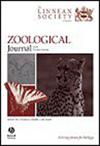不同的分类方法影响了南美洲塞拉多热带草原的鸟类特有性模式
IF 3
2区 生物学
Q1 ZOOLOGY
引用次数: 0
摘要
确定特有物种以及由这些物种划定的特有区域是生物地理学的核心。然而,不同的分类方法对这些模式的影响往往被忽视。我们研究了三种不同的分类方法如何影响塞拉多地区的鸟类特有性模式。前两种方法(物种和亚种水平)是基于生物物种概念的传统分类法。第三种方法基于修订后的替代分类法,旨在确定具有重要进化意义的单位(ESUs)。在第三种方法中,在使用传统分类法确定特有类群后,我们对其有效性进行了修订,删除了无生物意义的实体。然后,我们根据三种分类方法检测了这些特有类群所划分的特有性区域。我们发现,在物种水平上的传统分类法低估了鸟类的特有性,因为它忽略了一些被认为是亚种的 ESU。与此相反,亚种水平的传统分类法高估了鸟类的特有性,导致承认了一些虚假的特有性区域,因为一些所谓的特有亚种是分类学上的假象。修订后的分类法更精确地描述了塞拉多地区的鸟类特有性模式,表明使用生态系统服务单元可以改善生物地理学分析的结果。本文章由计算机程序翻译,如有差异,请以英文原文为准。
Distinct taxonomic practices impact patterns of bird endemism in the South American Cerrado savannas
Identifying endemic species and the areas of endemism delimited by them is central to biogeography. However, the impact of distinct taxonomic approaches on these patterns is often neglected. We investigated how three different taxonomic approaches impact the patterns of bird endemism in the Cerrado. The first two approaches (at species and subspecies levels) were based on traditional taxonomy based on the biological species concept. The third approach was based on a revised alternative taxonomy that sought to identify evolutionarily significant units (ESUs). In this third approach, after identifying the endemic taxa using traditional taxonomy, we revised their validity, removing biologically meaningless entities. We then detected the areas of endemism delimited by these endemic taxa under the three taxonomic approaches. We found that traditional taxonomy at the species level underestimated bird endemism by ignoring some ESUs that were considered subspecies. In contrast, traditional taxonomy at the subspecies level overestimated bird endemism, leading to the recognition of spurious areas of endemism because several of the purported endemic subspecies were taxonomic artefacts. The revised taxonomy provided a more refined picture of patterns of avian endemism in the Cerrado, suggesting that the use of ESUs improves the results of biogeographical analysis.
求助全文
通过发布文献求助,成功后即可免费获取论文全文。
去求助
来源期刊
CiteScore
6.50
自引率
10.70%
发文量
116
审稿时长
6-12 weeks
期刊介绍:
The Zoological Journal of the Linnean Society publishes papers on systematic and evolutionary zoology and comparative, functional and other studies where relevant to these areas. Studies of extinct as well as living animals are included. Reviews are also published; these may be invited by the Editorial Board, but uninvited reviews may also be considered. The Zoological Journal also has a wide circulation amongst zoologists and although narrowly specialized papers are not excluded, potential authors should bear that readership in mind.

 求助内容:
求助内容: 应助结果提醒方式:
应助结果提醒方式:


